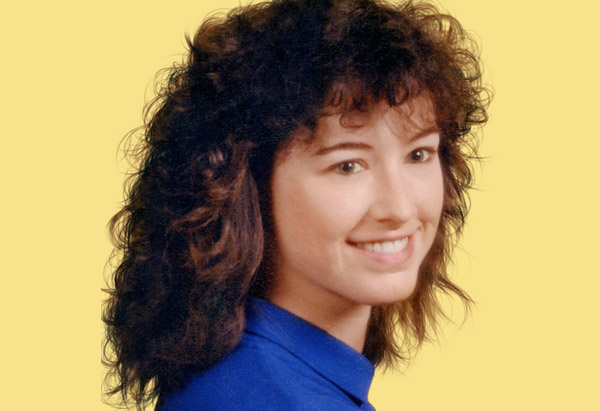
Photo: Courtesy of Jancee Dunn
Blame it on Bon Jovi: For far longer than the taste police would approve, Jancee Dunn has been living large. Like really large.
I grew up in New Jersey in the '80s. That means one thing: big hair. I've always had natural curls, but as a teenager, that didn't stop me from getting twice-yearly perms—with the small rollers, please, for maximum frizz—and dousing my hair each morning with a typhoon of Aqua Net. It was simply how you did it in those days. I had big hair, my boyfriends had big hair, we all had big hair. Our prom looked like the poodle division of the Westminster dog show. To me, a massive coif went hand in hand with wild, spontaneous trips down the Shore and like every teenage girl within 50 miles, I also knew that it made your butt look smaller. Even now, in my mid-40s, though I resist the urge to mousse, my hair is still pretty big. (Recently, glancing at my long curls in the mirror, it occurred to me that they have something in common with Louis XIV's wig—which means my hair isn't just a relic from the '80s, it's a relic from the 1680s.) I know big hair looks peculiar—I know it—but for me it's a sweet relic of a time when I was oblivious to the world's taste police. And so even though I've said goodbye to miniskirts and tube tops and other youth-only fashions, when my stylist begs me to please let her chop my hair off, I hesitate. I remember the dumb exuberance of my teenage years, and all that reckless fun I had, and the knowledge that my whole life still lay ahead of me—and I tell her to give me the usual.
—Jancee Dunn
Next: The arduous journey to hairdo destiny
I grew up in New Jersey in the '80s. That means one thing: big hair. I've always had natural curls, but as a teenager, that didn't stop me from getting twice-yearly perms—with the small rollers, please, for maximum frizz—and dousing my hair each morning with a typhoon of Aqua Net. It was simply how you did it in those days. I had big hair, my boyfriends had big hair, we all had big hair. Our prom looked like the poodle division of the Westminster dog show. To me, a massive coif went hand in hand with wild, spontaneous trips down the Shore and like every teenage girl within 50 miles, I also knew that it made your butt look smaller. Even now, in my mid-40s, though I resist the urge to mousse, my hair is still pretty big. (Recently, glancing at my long curls in the mirror, it occurred to me that they have something in common with Louis XIV's wig—which means my hair isn't just a relic from the '80s, it's a relic from the 1680s.) I know big hair looks peculiar—I know it—but for me it's a sweet relic of a time when I was oblivious to the world's taste police. And so even though I've said goodbye to miniskirts and tube tops and other youth-only fashions, when my stylist begs me to please let her chop my hair off, I hesitate. I remember the dumb exuberance of my teenage years, and all that reckless fun I had, and the knowledge that my whole life still lay ahead of me—and I tell her to give me the usual.
—Jancee Dunn
Next: The arduous journey to hairdo destiny
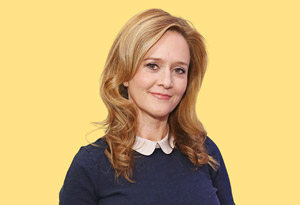
Photo: Neilson Barnard/Getty Images
The Daily Show's Samantha Bee on the arduous journey to hairdo destiny.
I wish I could be one of those lucky weirdos who are happy with their hair in its natural state—but I've always been sure I could do better than what Mother Nature intended. As a child I coiled my hair in rags to curl it as I slept, giving it a slightly lumpy quality; I had bed head for eight years. Later I went for a series of celebrity 'dos: the Nancy Wilson, the Anne Murray, the Suzi Quatro. I now have extensive photographic evidence that I look awful in bangs. As a teenager, I buzzed my hair on one side and dyed my head maroon, prompting my parents to take me to a psychiatrist, who asked me, "Why are you hiding behind your hair?" He had a point.
But my point is this: After decades of tweaking and torturing it into a dozen varieties of hideousness, I finally love my hair. It's a pretty color (somewhere between spun honey and baby deer) and a nice length (just below my shoulders), and it flatters my face. I put 43 years into thinking about my hair so I would no longer have to—only to realize that that's an impossible dream. Because now that my hair is perfect, I'm terrified something will go wrong. I suffer from recurring nightmares in which I lose my mind and decide to try a henna-and-bowl-cut combo again (yes, I said again), or a colorist accidentally bleaches it white, which is what happened ten years ago. (I still can't think about that incident without wanting to vomit a little; I can't talk about it without crying.) When someone unfamiliar does my hair—an unavoidable part of my job—it gives me a curious physical sensation, as though my center were dropping out.
What scares me more than anything is that no matter how well I protect my hair from having horrible things done to it, I can do absolutely nothing to stop it from changing on its own. Lately, wiry, cat-whisker hairs are sprouting from my crown, and my hair is growing dryer, even a bit—dare I say—brittle. There's a lesson to be learned here, I suppose, about the certainty of change. But it's awfully nice having that one thing, that reliable go-to in your life with which you're truly, finally content.
Okay, yes, fine, I also have my job, my husband, my children. Children, Mommy loves you. Just keep your fudgy fingers away from my hair.
—Samantha Bee
Next: How one woman learns to love her natural haircolor
I wish I could be one of those lucky weirdos who are happy with their hair in its natural state—but I've always been sure I could do better than what Mother Nature intended. As a child I coiled my hair in rags to curl it as I slept, giving it a slightly lumpy quality; I had bed head for eight years. Later I went for a series of celebrity 'dos: the Nancy Wilson, the Anne Murray, the Suzi Quatro. I now have extensive photographic evidence that I look awful in bangs. As a teenager, I buzzed my hair on one side and dyed my head maroon, prompting my parents to take me to a psychiatrist, who asked me, "Why are you hiding behind your hair?" He had a point.
But my point is this: After decades of tweaking and torturing it into a dozen varieties of hideousness, I finally love my hair. It's a pretty color (somewhere between spun honey and baby deer) and a nice length (just below my shoulders), and it flatters my face. I put 43 years into thinking about my hair so I would no longer have to—only to realize that that's an impossible dream. Because now that my hair is perfect, I'm terrified something will go wrong. I suffer from recurring nightmares in which I lose my mind and decide to try a henna-and-bowl-cut combo again (yes, I said again), or a colorist accidentally bleaches it white, which is what happened ten years ago. (I still can't think about that incident without wanting to vomit a little; I can't talk about it without crying.) When someone unfamiliar does my hair—an unavoidable part of my job—it gives me a curious physical sensation, as though my center were dropping out.
What scares me more than anything is that no matter how well I protect my hair from having horrible things done to it, I can do absolutely nothing to stop it from changing on its own. Lately, wiry, cat-whisker hairs are sprouting from my crown, and my hair is growing dryer, even a bit—dare I say—brittle. There's a lesson to be learned here, I suppose, about the certainty of change. But it's awfully nice having that one thing, that reliable go-to in your life with which you're truly, finally content.
Okay, yes, fine, I also have my job, my husband, my children. Children, Mommy loves you. Just keep your fudgy fingers away from my hair.
—Samantha Bee
Next: How one woman learns to love her natural haircolor
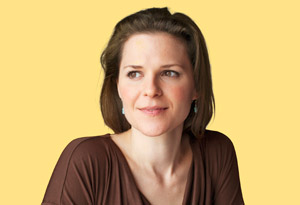
Photo: Courtesy of Michelle Wildgen
Michelle Wildgen loved being a blonde—right up until she didn't.
Even as a fifth-grader, I hated my haircolor: muddy brown. I'd load it with lemon and roast in the sun, picturing the alchemy I'd soon see revealed in the mirror. My shade was a blight that made every attempt at a hairstyle seem misguided.
And then, in my teens, my mother let me get highlights and I went from dull brown to decidedly flaxen. Believing, in my teenage way, that I could shift the world on its very axis by being blonde and smart, I overdid both, carping about my intellect and arranging my hair into a golden cumulonimbus. I wore scarlet lipstick; my hair seemed to demand it. Though my style shifted throughout my teens and 20s—short, long, wavy, curly—the shade was nonnegotiable. I thought of myself emphatically as A Blonde.
But while part of the allure of blonde hair is its impression of effortlessness—gold is the very color of luck, after all—the truth is that for everyone but children, Swedes and elves, being blonde requires a lot of upkeep and money. Whenever I moved to a new city, I had to begin an anxious search for a dye master who could find that elusive zone between brassy and ash. After a decade of this, my prized fairness began to seem a bit desperate, a tad obvious. (A brunette who wants to be blonde—you don't say.)
Maybe I was tired, but one day I just gave up.
I couldn't help noticing that shortly after I went brunette, a number of celebrities did, too. Nor can I blame them. (Bravo, Reese.) I loved being brunette again. My haircolor flattered my skin tone and matched my brown eyes better than the blonde ever had.
These days I catch myself thinking of depth, of darkness: mahogany, raven, glossy chocolate. The perfect brown is shiny, not too dark, touched with gold rather than copper, more fawn than fox. It's shot through with variegated color: maple, raw sugar, caramel, cocoa. Sometimes I lose track of my own imaginings and just start listing everything good that is brown. The list gets longer all the time.
—Michelle Wildgen
Next: Two women with the same autoimmune disease—two very different takes on losing it all
Even as a fifth-grader, I hated my haircolor: muddy brown. I'd load it with lemon and roast in the sun, picturing the alchemy I'd soon see revealed in the mirror. My shade was a blight that made every attempt at a hairstyle seem misguided.
And then, in my teens, my mother let me get highlights and I went from dull brown to decidedly flaxen. Believing, in my teenage way, that I could shift the world on its very axis by being blonde and smart, I overdid both, carping about my intellect and arranging my hair into a golden cumulonimbus. I wore scarlet lipstick; my hair seemed to demand it. Though my style shifted throughout my teens and 20s—short, long, wavy, curly—the shade was nonnegotiable. I thought of myself emphatically as A Blonde.
But while part of the allure of blonde hair is its impression of effortlessness—gold is the very color of luck, after all—the truth is that for everyone but children, Swedes and elves, being blonde requires a lot of upkeep and money. Whenever I moved to a new city, I had to begin an anxious search for a dye master who could find that elusive zone between brassy and ash. After a decade of this, my prized fairness began to seem a bit desperate, a tad obvious. (A brunette who wants to be blonde—you don't say.)
Maybe I was tired, but one day I just gave up.
I couldn't help noticing that shortly after I went brunette, a number of celebrities did, too. Nor can I blame them. (Bravo, Reese.) I loved being brunette again. My haircolor flattered my skin tone and matched my brown eyes better than the blonde ever had.
These days I catch myself thinking of depth, of darkness: mahogany, raven, glossy chocolate. The perfect brown is shiny, not too dark, touched with gold rather than copper, more fawn than fox. It's shot through with variegated color: maple, raw sugar, caramel, cocoa. Sometimes I lose track of my own imaginings and just start listing everything good that is brown. The list gets longer all the time.
—Michelle Wildgen
Next: Two women with the same autoimmune disease—two very different takes on losing it all
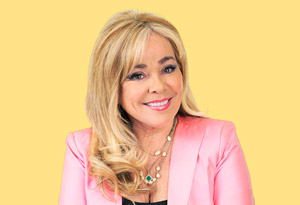
Photo: Courtesy of Lucinda Ellery Consultancy
Lucinda Ellery makes a case for keeping it unreal.
How she got into the fake hair business
When I was 9, I lost two-thirds of my hair overnight. I learned later that I had alopecia areata; my immune system was attacking my hair follicles. I got my first wig when I was 12—it was one of the best days of my life. I wore wigs for 23 years. Then, in the mid-'80s, I tried extensions, but back then the process was primitive and very damaging. I decided I could do it better.
How she does it better
I weave my clients' remaining hair through a light mesh cap of extensions that they can leave on day and night.
Her client base
I see a lot of genetic female pattern hair loss and cancer treatment hair loss.
The hair she presents to the world
Long, thick, blonde.
The hair she really has
A short black ball of frizz with bald patches.
Why she'll never just shave it all off
That would feel like a terrible punishment to me. I will go to my grave with long, blonde hair. I don't feel like myself without it.
Lucinda Ellery owns salons in London, Manchester, Edinburgh, and Los Angeles.
Next: Why wigs aren't for one interior designer
The Cover-Up
How she got into the fake hair business
When I was 9, I lost two-thirds of my hair overnight. I learned later that I had alopecia areata; my immune system was attacking my hair follicles. I got my first wig when I was 12—it was one of the best days of my life. I wore wigs for 23 years. Then, in the mid-'80s, I tried extensions, but back then the process was primitive and very damaging. I decided I could do it better.
How she does it better
I weave my clients' remaining hair through a light mesh cap of extensions that they can leave on day and night.
Her client base
I see a lot of genetic female pattern hair loss and cancer treatment hair loss.
The hair she presents to the world
Long, thick, blonde.
The hair she really has
A short black ball of frizz with bald patches.
Why she'll never just shave it all off
That would feel like a terrible punishment to me. I will go to my grave with long, blonde hair. I don't feel like myself without it.
Lucinda Ellery owns salons in London, Manchester, Edinburgh, and Los Angeles.
Next: Why wigs aren't for one interior designer
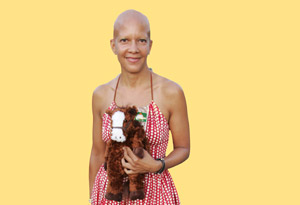
Photo: George Chinsee/The Bald Mermaid
The reason she really loved her hair
It represented the untamable me.
And how she lost it
When I was 38, two tiny bald patches on the back of my head led to a diagnosis of alopecia areata.
What prompted her to shave her head
It was a fuck you to the universe. My hair was falling out, and I thought if I shaved my head I would feel as if I were taking back some power.
How that allowed her to move on
I did feel empowered, but I also felt grief. And when I allowed myself to feel the grief, I just knew that it wouldn't last forever.
Why wigs aren't for her
I was never the kind of person who spent a lot of time on her hair. I play tennis in the heat, I ride a horse, and I will not be tucking a wig under my helmet. I don't knock other people if they want to wear a wig, but for me, it didn't make me comfortable with who I saw in the mirror.
Sexy, feminine and bald?
Yes, I think so!
Sheila Bridges's memoir, The Bald Mermaid (Pointed Leaf), explores issues of identity, femininity, and success.
Next: The hardships of the female crew cut
It represented the untamable me.
And how she lost it
When I was 38, two tiny bald patches on the back of my head led to a diagnosis of alopecia areata.
What prompted her to shave her head
It was a fuck you to the universe. My hair was falling out, and I thought if I shaved my head I would feel as if I were taking back some power.
How that allowed her to move on
I did feel empowered, but I also felt grief. And when I allowed myself to feel the grief, I just knew that it wouldn't last forever.
Why wigs aren't for her
I was never the kind of person who spent a lot of time on her hair. I play tennis in the heat, I ride a horse, and I will not be tucking a wig under my helmet. I don't knock other people if they want to wear a wig, but for me, it didn't make me comfortable with who I saw in the mirror.
Sexy, feminine and bald?
Yes, I think so!
Sheila Bridges's memoir, The Bald Mermaid (Pointed Leaf), explores issues of identity, femininity, and success.
Next: The hardships of the female crew cut
What part of short don't you understand?
Alison Bechdel describes the hardships of the female crew cut.
The shorter my hair is, the better I feel. Yes, I'm a lesbian of a certain age, but even as a girl I craved a crew cut, and I've stayed closely cropped long since the look ceased to be fashionable. It's the only cut for me. But it does have its challenges. If I don't get my hair cut every four weeks, I feel funny in public. And to make it stand up just so requires some seriously overpriced product. (Per linear inch, it's possible that I fuss over my hair as much as several Kardashians combined.) It's tough to get a decent cut where I live in quasi-rural Vermont. The barbershop that does the state troopers won't cut women's hair, so for years I went to the sole African American salon in town, where the barber had no qualms about giving me a fade so sharp it looked drawn-on. I get called sir a lot, and I routinely endure double takes in the ladies' room. Sometimes it escalates to verbal confrontation. But then I say, "It's okay," and once people hear my (obviously feminine) voice, they apologize.
I wish it weren't such a big deal. But what can I do? I have to keep it short. Luckily, because I travel a lot, I can find good barbershops. I like a factory atmosphere best—no chitchat, no fuss. Just a brisk, clean clip and a dusting of Clubman Talc is fine by me.
—Alison Bechdel
More on Loving Your Hair




